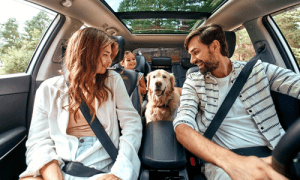Maintaining the health of your dog involves similar principles, including proper nutrition, regular veterinary care, exercise, and a safe environment. Here are some tips for keeping your dog healthy:
Fueling Your Dog’s Health with a Well-Balanced Diet:
Provide a well-balanced, high-quality dog food suitable for your dog’s age, size, and health needs. Consult with your veterinarian for dietary recommendations.
Hydration Essentials: Providing Clean and Fresh Water for Your Dog:
Always make sure your dog has access to clean and fresh water.
Proactive Care: Scheduling Essential Veterinary Visits for Your Dog:
Schedule regular veterinary visits for check-ups, vaccinations, and preventive care. Early detection of health issues is crucial.
Guarding Your Dog Against Fleas, Ticks, and Worms:
Protect your dog from fleas, ticks, and worms by using preventive medications as recommended by your veterinarian.
Active Paws: Incorporating Regular Physical Activity into Your Dog’s Routine:
Dogs need regular physical activity for their overall well-being. Take your dog for walks, play fetch, or engage in other activities to keep them active.
Maintaining a Healthy Coat: Brushing, Bathing, and Nail Trimming:
Brush your dog’s coat regularly to prevent matting and reduce shedding. Depending on the breed, your dog may also need regular baths and nail trims.
Bright Smiles: Prioritizing Dental Health for Your Dog:
Dental health is important. Brush your dog’s teeth regularly and provide dental treats or toys to help keep their teeth clean.
Dog-Proofing Your Home: Ensuring a Safe Living Space for Your Pet:
Ensure your home and yard are safe for your dog. Remove hazardous items, secure fences, and provide a comfortable and secure living space.
Health Benefits and Behavioral Impact of Spaying/Neutering Your Dog:
Consider spaying or neutering your dog to prevent certain health issues and unwanted behaviors.
Understanding Canine Signals: Staying Alert to Behavioral Changes:
Be attentive to any changes in your dog’s behavior, eating habits, or bathroom habits. Sudden changes may signal a health concern.
Building Canine Confidence: The Importance of Socialization:
Socialize your dog with other animals and people to help them develop good behavior and reduce anxiety.
Tagged and Tracked: Ensuring Your Dog’s Safety with Proper Identification:
Ensure your dog has proper identification, such as a collar with ID tags and a microchip. This is crucial in case your dog gets lost.
Remember that each dog is unique, and their needs may vary based on factors like breed, size, and age. Consult with your veterinarian for personalized advice and care recommendations for your specific dog.









